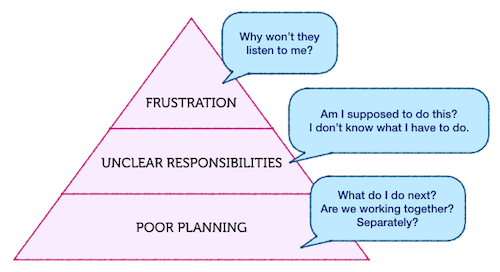Doing the work
Once you have built a strong foundation for group work by using the strategies previously outlined, it’s time to get down to work.
To meet the task requirements, group members will be busy with different responsibilities at the same time. Focus on communicating and collaborating to successfully manage yourselves and the task.
Strategy 1: Hold regular meetings
- Use an agenda to keep meetings focussed on the task.
- Actively contribute to discussions using inclusive and respectful language.
- Be open to different ideas and different perspectives.
- Ensure everyone has a say. Sometimes people find it difficult to voice their opinions. They may feel dominated by more confident speakers. Listen when others are speaking and encourage the quiet members to contribute.
- Check and measure progress against the timeline.
- Meetings are an opportunity for the group to reconnect, review progress, provide feedback and make any necessary changes.
Strategy 2: Give each other constructive feedback
- Give positive feedback to motivate and encourage team members. Always start with genuine, positive feedback: say what you appreciate about their work before offering critical feedback.
Be sensitive to how others may respond to criticism. Be nice. - Use the S.M.A.R.T. principles to focus your feedback on the task:

Specific
Focus on actual examples of the work or performance. General or vague statements are unhelpful.

Action-oriented
Align actions with the task requirements. If a change is required, what needs to happen?
Strategy 3: Deal with challenging behaviours and conflict

Which group member are you?

Zombie
Unengaged and unmotivated. May ‘disappear’ for weeks or completely.

Team player
Collaborative, communicative, committed.

Hitchhiker
'Along for the ride', does minimal work but shares the results.

Superhero
Comes to the 'rescue' by taking over every task. A group of one!
- Identify and acknowledge any conflict or dissatisfaction early. Disagreements arise when members lack clear directions or feel their knowledge and skills are ignored or criticised.
- Communicate any problems to the whole group and try to resolve the problem quickly, as a group. You will need to negotiate and compromise.
- Manage group dynamics
Groups are made up of people with different expectations. For example, some students are happy just to pass while others aim for high marks.
Sometimes these differences can cause tension. This is normal – all groups experience highs and lows when working on complex projects over a period of time.
Do you recognise any of these people and their behaviours and attitudes in your group? - Seek help from your lecturer or other academic support services if your group is unable to agree on a solution.
The diagram below shows how issues can often build upon one another.
You are always going to encounter diversity within groups. The best way to ensure an effective group work experience is to develop a strong process with your group members.
Strategy 1: Use agendas in meetings
- Use the agenda as a checklist to ensure that all the task criteria have been met.
- Record decisions for actions, roles and responsibilities to provide clear direction to group members.
- Measure agenda actions against the timeline to help the team stay on track. Be prepared to adjust the timeline as the project progresses.
Strategy 2: Manage tasks and resources
- Organise information so that it is shareable and accessible to everyone.
There are many online collaborative tools and apps to choose from. Remember to keep it simple!
- Create the final product.
Your final submission may have specific requirements. Delegate responsibilities among group members for completing the work.
Follow the strategies for Wrapping up.
Managing the group
Strategy 1: Hold regular meetings
- Use an agenda to keep meetings focussed on the task.
- Actively contribute to discussions using inclusive and respectful language.
- Be open to different ideas and different perspectives.
- Ensure everyone has a say. Sometimes people find it difficult to voice their opinions. They may feel dominated by more confident speakers. Listen when others are speaking and encourage the quiet members to contribute.
- Check and measure progress against the timeline.
- Meetings are an opportunity for the group to reconnect, review progress, provide feedback and make any necessary changes.
Strategy 2: Give each other constructive feedback
- Give positive feedback to motivate and encourage team members. Always start with genuine, positive feedback: say what you appreciate about their work before offering critical feedback.
Be sensitive to how others may respond to criticism. Be nice. - Use the S.M.A.R.T. principles to focus your feedback on the task:

Specific
Focus on actual examples of the work or performance. General or vague statements are unhelpful.

Action-oriented
Align actions with the task requirements. If a change is required, what needs to happen?
Strategy 3: Deal with challenging behaviours and conflict
Which group member are you?

Zombie
Unengaged and unmotivated. May ‘disappear’ for weeks or completely.

Team player
Collaborative, communicative, committed.

Hitchhiker
'Along for the ride', does minimal work but shares the results.

Superhero
Comes to the 'rescue' by taking over every task. A group of one!
- Identify and acknowledge any conflict or dissatisfaction early. Disagreements arise when members lack clear directions or feel their knowledge and skills are ignored or criticised.
- Communicate any problems to the whole group and try to resolve the problem quickly, as a group. You will need to negotiate and compromise.
- Manage group dynamics
Groups are made up of people with different expectations. For example, some students are happy just to pass while others aim for high marks.
Sometimes these differences can cause tension. This is normal – all groups experience highs and lows when working on complex projects over a period of time.
Do you recognise any of these people and their behaviours and attitudes in your group? - Seek help from your lecturer or other academic support services if your group is unable to agree on a solution.
You are always going to encounter diversity within groups. The best way to ensure an effective group work experience is to develop a strong process with your group members.
Managing the task
Strategy 1: Use agendas in meetings
- Use the agenda as a checklist to ensure that all the task criteria have been met.
- Record decisions for actions, roles and responsibilities to provide clear direction to group members.
- Measure agenda actions against the timeline to help the team stay on track. Be prepared to adjust the timeline as the project progresses.
Strategy 2: Manage tasks and resources
- Organise information so that it is shareable and accessible to everyone.
There are many online collaborative tools and apps to choose from. Remember to keep it simple!
- Create the final product.
Your final submission may have specific requirements. Delegate responsibilities among group members for completing the work.
Follow the strategies for Wrapping up.



